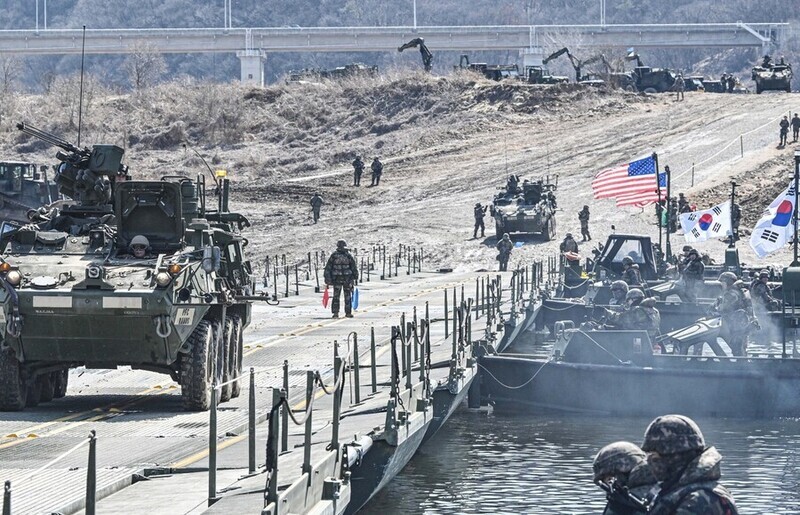hankyoreh
Links to other country sites 다른 나라 사이트 링크
Winds of crisis to blow across Korea in March as drills, propaganda pick up

At the end of December, North Korean leader Kim Jong-un urged his military to make “preparations for a great event to suppress the whole territory of South Korea.” On Monday, during a meeting of the Supreme People's Assembly, he argued that the North’s constitution be revised to address “completely occupying, subjugating and reclaiming the ROK and annex[ing] it as a part of the territory of our Republic,” describing South Korea as North Korea’s “principal enemy.”
The chances of an unintended skirmish in the border region continues to elevate following the collapse of the Sept. 19 inter-Korean military agreement, a buffer-creating pact signed in 2018 that served to prevent military conflict, as South Korea’s government has hit back at Pyongyang by calling for the collapse of the North Korean regime.
With US-South Korea joint military exercises as well as a general election in South Korea on the calendar for this spring, it looks to be a season of unprecedented crisis on the Korean Peninsula.
The most notable of the aforementioned joint exercises is the Ulchi Freedom Shield, a two-week series of exercises scheduled for March. Originally, these exercises were mostly carried out via computer simulations. Starting last year, however, the exercises began incorporating more live training, featuring large-scale formations and heavy equipment. US nuclear-powered aircraft carriers and strategic bombers are expected to arrive in South Korea. North Korea has lambasted South Korea-US military exercises as “war games” done in preparation for an invasion of North Korea,” responding with its own exercises as well as missile launches.
North Korea normally conducts its winter exercises from December to March. Now that the Sept. 19 military pact has gone up in smoke, Pyongyang is expected to conduct live artillery drills and tactical exercises on the regiment level along the Military Demarcation Line. As all military communication channels between the two Koreas have been cut off, there’s an increased chance of a misfire or a misunderstanding that leads to an armed clash.
Whether civilian organizations will resume the release of propaganda balloons from near the inter-Korean border also remains a variable. While prevailing westerly winds impede the flight of such balloons over the border in the winter, there’s a good chance that groups will begin sending them once there’s a change in the wind in March. Were North Korea to use anti-air artillery to try to shoot down the propaganda balloons, it could end with bullets falling south of the armistice line, leading to kinetic engagement between South and North.
Once the ice thaws by late March, the North will begin its naval field maneuvers and artillery drills in the vicinity of the Northern Limit Line off the peninsula’s western coast. May and June are when the blue crab fisheries near Yeonpyeong Island are busiest; these crab crops bring fishing vessels from North and South Korea to this border area, which in turn prompts the North and South Korean navies to enter the waters as well. The two battles of Yeonpyeong Island (1999 and 2002) both occurred in June.
The risk of an armed clash near the Northern Limit Line this year is higher than usual. During a meeting of the Supreme People's Assembly on Monday, Kim Jong-un said, “The illegal ‘northern limit line’ and any other boundary can never be tolerated, and if the ROK violates even 0.001 mm of our territorial land, air and waters, it will be considered a war provocation.”
In response, Jeon Ha-gyu, the spokesperson from South Korea’s Ministry of National Defense, said, “The NLL is the de facto maritime border that has been defended with the lives of many of our fallen soldiers, and it is our military’s resolute stance that it will protect and defend the NLL whatever the circumstances may be.”
By Kwon Hyuk-chul, staff reporter
Please direct questions or comments to [english@hani.co.kr]

Editorial・opinion
![[Editorial] Intensifying US-China rivalry means Seoul must address uncertainty with Beijing sooner than later [Editorial] Intensifying US-China rivalry means Seoul must address uncertainty with Beijing sooner than later](https://flexible.img.hani.co.kr/flexible/normal/500/300/imgdb/original/2024/0517/8117159322045222.jpg) [Editorial] Intensifying US-China rivalry means Seoul must address uncertainty with Beijing sooner than later
[Editorial] Intensifying US-China rivalry means Seoul must address uncertainty with Beijing sooner than later![[Column] When ‘fairness’ means hate and violence [Column] When ‘fairness’ means hate and violence](https://flexible.img.hani.co.kr/flexible/normal/500/300/imgdb/original/2024/0516/7417158465908824.jpg) [Column] When ‘fairness’ means hate and violence
[Column] When ‘fairness’ means hate and violence- [Editorial] Yoon must stop abusing authority to shield himself from investigation
- [Column] US troop withdrawal from Korea could be the Acheson Line all over
- [Column] How to win back readers who’ve turned to YouTube for news
- [Column] Welcome to the president’s pity party
- [Editorial] Korea must respond firmly to Japan’s attempt to usurp Line
- [Editorial] Transfers of prosecutors investigating Korea’s first lady send chilling message
- [Column] Will Seoul’s ties with Moscow really recover on their own?
- [Column] Samsung’s ‘lost decade’ and Lee Jae-yong’s mismatched chopsticks
Most viewed articles
- 1For new generation of Chinese artists, discontent is disobedience
- 2[Editorial] Transfers of prosecutors investigating Korea’s first lady send chilling message
- 3S. Korea “monitoring developments” after report of secret Chinese police station in Seoul
- 4Xi, Putin ‘oppose acts of military intimidation’ against N. Korea by US in joint statement
- 5[Exclusive] Unearthed memo suggests Gwangju Uprising missing may have been cremated
- 6N. Korean media upgrades epithet for leader’s daughter from “beloved” to “respected”
- 7Yoon says concern about biased diplomacy is being incited by “communist totalitarian forces”
- 8[Column] US troop withdrawal from Korea could be the Acheson Line all over
- 9[Editorial] Intensifying US-China rivalry means Seoul must address uncertainty with Beijing sooner t
- 10[Interview] Recalling seeing soldiers secretly burying bodies behind Gwangju Prison